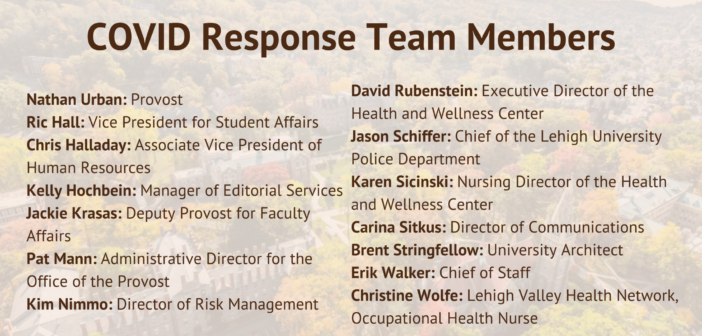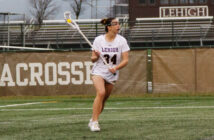During the summer of 2020, members of Lehigh’s administration created the COVID Response Team (CRT) as a way to oversee and implement COVID-19 related decisions on campus. Since then, the Lehigh community has received dozens of communications from the CRT that detail important updates and changes in protocol.
Over the past three semesters, the CRT has been a crucial part of the Lehigh experience, yet the specifics of this team remain unknown to much of the Lehigh community since their meetings are not open to the community and they do not release the minutes.
The CRT consists of 14 administrators that represent different sectors of the university, including health and wellness, facilities, communications, risk management, academics and more.
Ric Hall, vice president for student affairs and member of the CRT, said the CRT meets daily to discuss COVID-19 related issues and make decisions that impact the entire university. He said that outside of their standing meetings, the CRT occasionally meets in the mornings or on the weekends to discuss matters on campus as they arise.
Each day, Hall said an hour is blocked off on their calendars for the meeting, and just about every time they are there for the full hour, if not spilling over.
“We know that it’s important that we are giving due diligence to every matter that comes before us,” he said.
A subset of the CRT also meets weekly with representatives from the Undergraduate Student Senate, Graduate Student Senate and Faculty Senate. Provost, Senior Vice President and member of the CRT, Nathan Urban, said the CRT receives requests from these representatives, which can result in policy changes.
Victor Cochrane, ‘22, Student Senate president, said that the CRT listens to student input when they can. Cochrane says he and other representatives raised concerns about a lack of surveillance testing, and a new policy was implemented by the CRT to test 10 percent of vaccinated students regularly.
“Last year, there was a lot of uncertainty surrounding health and safety, so if a student said something, I think the team was a lot more hesitant to implement that, while this year with lower case numbers, I think they can be more accommodating towards students,” Cochrane said.
Urban said most decisions are made by consensus after discussion.
If something is strictly health-related, Urban said those involved in the health center will have an outsized role in the discussion, and the same goes for other targeted issues like staffing or facilities.
“I can’t think of any issue where it has come down to a vote in the traditional sense,” he said. “Usually, there’s been enough agreement and enough consensus that it emerges over the course of a discussion.”
David Rubenstein, executive director of the Health and Wellness Center, and member of the CRT, said a key component of decision making is having close communication with the Bethlehem Health Bureau, Lehigh Valley Health Network, and review of the Pennsylvania Department of Health and the Center for Disease Control recommendations.
“We as a group are always looking at campus status, looking at case counts, looking at what’s happening in the region across the country and some of those changes in campus status arise from us directly,” Urban said.
There are people on the CRT from a variety of spaces on campus, like facilities and human resources, to make sure what is decided can be implemented and receive different views of what’s happening across campus, Urban said.
He said at different times they will bring in people from housing, LTS or dining if they need to make a change involving a specific department.
Before the creation of the CRT, Brent Stringfellow, associate vice president, university architect, and member of the CRT, said four task forces were formed to assist with long-term COVID-19 related planning. The task forces, which do not meet as frequently as the CRT, handle the physical reopening of campus, academic planning, financial planning and forward-thinking planning beyond the pandemic.
The task forces are comprised of administrators and faculty members. Some members of the CRT are also involved with one or more of the task forces.
Urban said all of the universities he keeps tabs on have a similar type of team established. He said he watches around 30 to 40 other campuses to learn and compare.
Urban said when the CRT was first created, former President John Simon and other vice presidents picked the members. Since then, he said there have been some minor modifications to the makeup.






Comment policy
Comments posted to The Brown and White website are reviewed by a moderator before being approved. Incendiary speech or harassing language, including comments targeted at individuals, may be deemed unacceptable and not published. Spam and other soliciting will also be declined.
The Brown and White also reserves the right to not publish entirely anonymous comments.